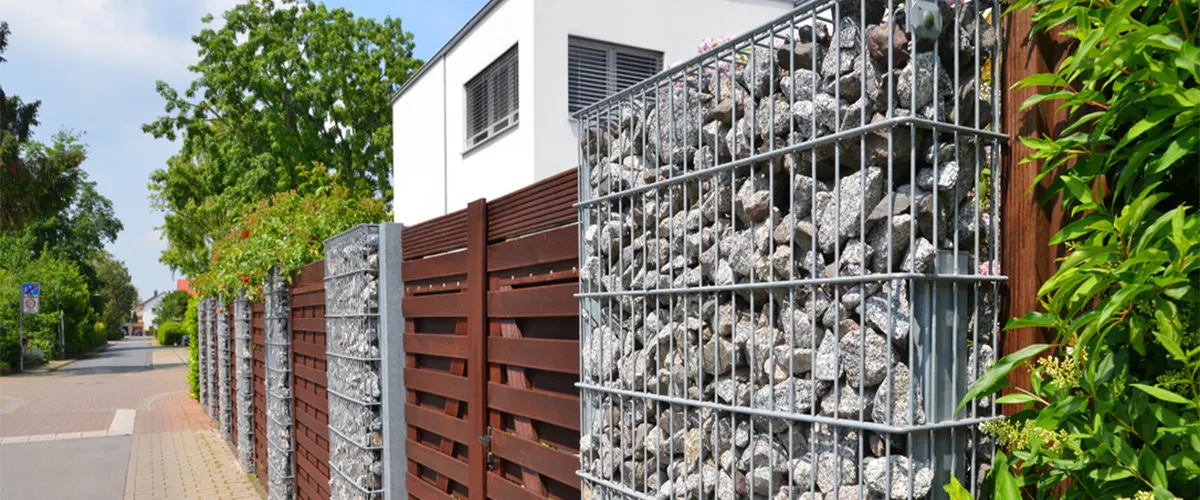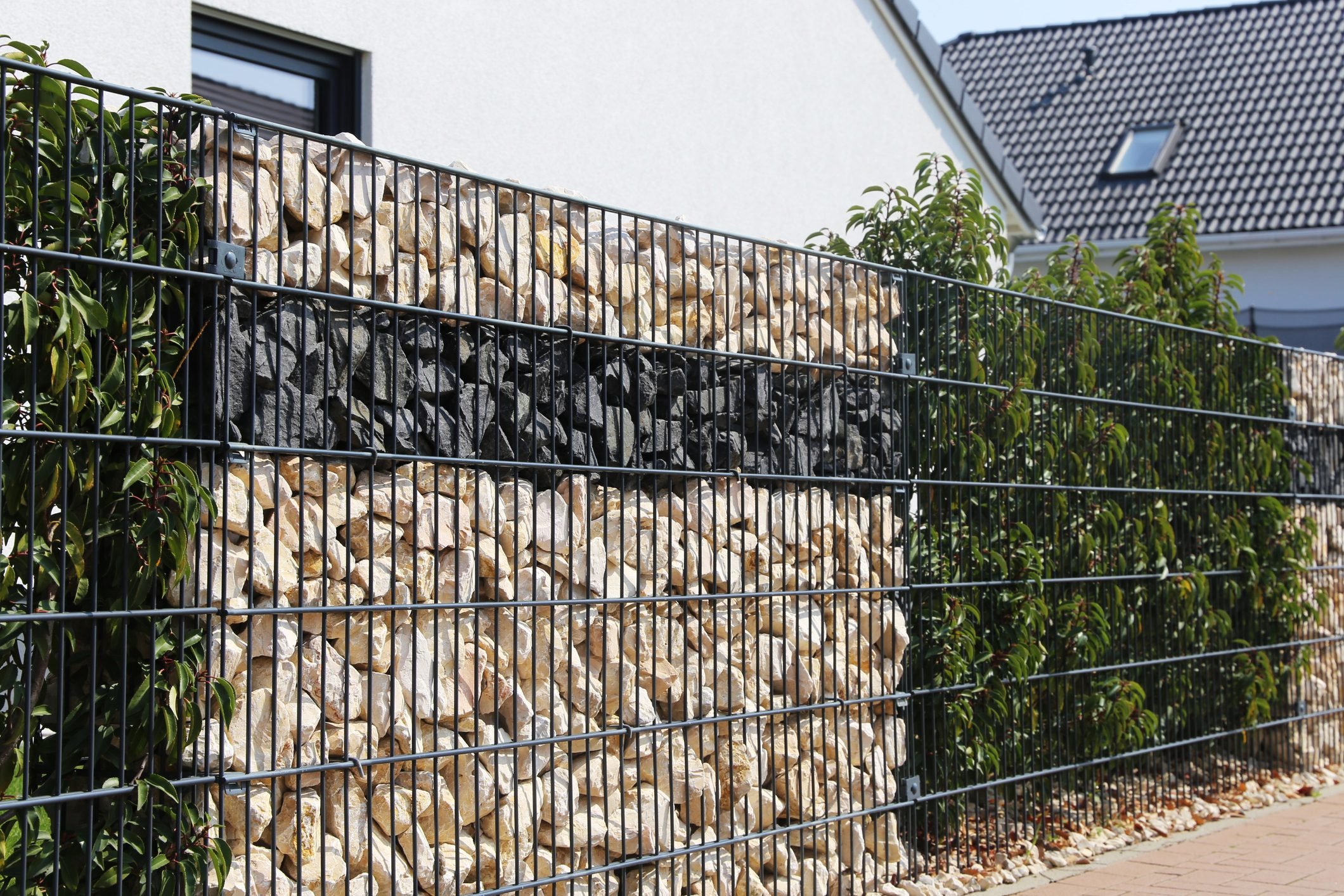Are you looking for a unique, durable, and eco-friendly fencing option for your property? Gabion fences might be the perfect solution for you. Originating from ancient engineering practices, gabion fences are constructed using wire cages filled with stones, offering both strength and style. They have gained popularity in modern landscaping due to their versatility and rustic charm. Whether you want to enhance your garden’s aesthetics, provide privacy, or create a sturdy boundary, gabion fences can meet your needs.
In this blog, we will explore everything you need to know about gabion fences, from their benefits and design possibilities to installation tips and maintenance requirements. Get ready to discover why these fences are becoming a top choice for homeowners and landscape designers alike.
What is Gabion Fence?

A gabion fence is a type of fencing constructed using gabions, which are large cages or baskets made of wire mesh. These cages are filled with various materials, such as rocks, gravel, or other aggregates, to create a sturdy and durable barrier. These type of fences are valued for their robustness and ability to blend seamlessly with natural landscapes, offering both functional and aesthetic benefits.
The design of a gabion fencing allows it to act as a solid structure that can withstand significant pressure and environmental stress. This makes it a popular choice for applications such as erosion control, retaining walls, and noise barriers. Additionally, these fences can be customized to fit various sizes and shapes, providing flexibility in design. They also offer excellent durability and low maintenance requirements, as the materials inside the wire mesh are protected from the elements and require minimal upkeep over time.
Benefits of Gabion Fence?

Durability
Gabion fences are extremely durable and can withstand harsh weather conditions, erosion, and physical impact. The combination of strong wire mesh and solid stones ensures long-lasting performance. Unlike traditional fences that may deteriorate over time, gabion fences maintain their structural integrity for many years. Their robust construction allows them to endure significant weight and pressure, making them a reliable barrier.
Eco-Friendliness
These fences are environmentally friendly as they use natural or recycled materials. The stones and gravel can often be sourced locally, reducing the environmental footprint. Additionally, the construction process of gabion fences is less harmful to the environment compared to manufacturing traditional fencing materials. By using sustainable resources and reducing the need for synthetic materials, gabion fences contribute to eco-conscious landscaping.
Aesthetic Appeal
Gabion fences have a unique, rustic appearance that can enhance the visual appeal of a property. They can be customized with different types of stones to match various design preferences. This flexibility in design allows homeowners and designers to create visually striking and harmonious landscapes. Whether used in residential gardens or commercial settings, gabion fences add a touch of natural beauty and elegance.
Sound Insulation
The dense, solid structure of gabion fences provides excellent sound insulation, making them ideal for use in urban areas or near busy roads to reduce noise pollution. This makes them particularly useful for creating peaceful outdoor spaces in noisy environments. By dampening unwanted sounds, gabion fences contribute to a more tranquil and enjoyable atmosphere in your yard or garden.
Erosion Control
Gabion fences are effective in controlling erosion and stabilizing slopes. They are commonly used in landscaping and civil engineering projects to prevent soil erosion. Their porous nature allows water to pass through, reducing the risk of flooding and maintaining soil integrity. This erosion control capability makes gabion fences valuable for properties located on hilly or uneven terrain.
Cost-Effectiveness
While the initial cost of materials and installation might be higher than some traditional fences, gabion fences require minimal maintenance. This long-term cost efficiency, combined with their durability, makes them a smart investment for many property owners. Once installed, gabion fences typically need little to no upkeep, saving time and money over the years.
Wind Reduction
Gabion fences can act as effective windbreaks, reducing the impact of strong winds on your property. The permeable structure allows some air to pass through while breaking the force of the wind, protecting plants, outdoor furniture, and other structures from wind damage. This wind reduction benefit makes gabion fences a practical choice for areas prone to high winds, providing both protection and comfort.
Drawbacks of Gabion Fence?

High Initial Cost
The initial cost of materials and installation for gabion fences can be relatively high compared to traditional fencing options. The cost includes purchasing the wire mesh, stones, and the labor required for assembly. While they are cost-effective in the long term due to low maintenance, the upfront expense can be a deterrent for some property owners.
Heavy Construction
Gabion fences are heavy due to the weight of the stones used in the construction. This can make transportation and installation more challenging, particularly in areas with difficult access or soft ground. The heavy nature of gabion fences may also require additional support structures or reinforcement during installation.
Limited Flexibility
Once installed, these fences are relatively permanent and difficult to modify or remove. If you want to change the design or location of the fence, it can be a cumbersome process. This lack of flexibility might be a drawback if you anticipate needing to adjust the fence in the future.
Maintenance of Stones
Over time, the stones in a gabion fence may become dislodged or shifted, especially if the fence is subjected to heavy impacts or shifting soil. While these fences require minimal maintenance overall, ensuring that the stones remain in place may require occasional adjustments or repairs.
Weed Growth and Debris Accumulation
The gaps between the stones in gabion fences can trap leaves, weeds, and other debris. This can lead to unsightly accumulation and may require periodic cleaning to maintain the appearance and functionality of the fence. Additionally, weed growth in the gaps can be difficult to manage and may require extra effort to control.
How to maintain your Gabion Fence?

- Inspect Regularly: Periodically check the gabion fence for any signs of damage or wear. Look for displaced or loose stones, rust on the wire mesh, or any structural issues. Regular inspections help catch problems early before they escalate.
- Check and Repair the Wire Mesh: The wire mesh is crucial in holding the stones in place. Inspect the mesh for any rust or damage, especially if you live in a humid or coastal area where corrosion is more likely. Repair any tears or holes in the mesh promptly to prevent stones from falling out and to maintain the structural integrity of the fence.
- Replace Dislodged Stones: Over time, stones may become dislodged or shift due to external factors like heavy impacts, soil movement, or settling. Refill or reposition stones as needed to maintain the fence’s appearance and functionality. This can be done by carefully removing the affected stones and replacing them.
- Manage Vegetation and Debris: The gaps between the stones can accumulate leaves, weeds, and other debris. Regularly clean out these gaps to prevent build-up and ensure proper drainage. Removing debris helps prevent weed growth and keeps the fence looking tidy.
- Control Erosion: If the gabion fence is located on a slope or area prone to erosion, monitor the surrounding soil and landscaping. Implement erosion control measures such as planting ground cover or using landscaping fabric to reduce soil movement and maintain the stability of the fence.
- Address Rust Issues: If you notice rust forming on the wire mesh, treat it with a rust-inhibiting solution or paint. Preventative measures can extend the life of the mesh and reduce the risk of structural failure due to corrosion.
- Inspect the Foundation: Ensure the foundation of the gabion fence remains stable and secure. Check for any signs of shifting or settling that might affect the fence’s alignment and structural integrity. Make adjustments or reinforce the foundation if necessary.
Conclusion
Gabion fences offer a unique blend of durability, aesthetic appeal, and functionality, making them an excellent choice for various applications. Their benefits, such as enhanced wind reduction and low maintenance requirements, make them a practical option for many property owners. While there are some drawbacks, such as potential long-term costs and aesthetic limitations, the advantages often outweigh the negatives.
By understanding the key aspects of these fences, including their maintenance needs and potential benefits, you can make an informed decision about whether this fencing option is right for your property. Embracing the versatility of gabion fences could well enhance the overall look and functionality of your space.





